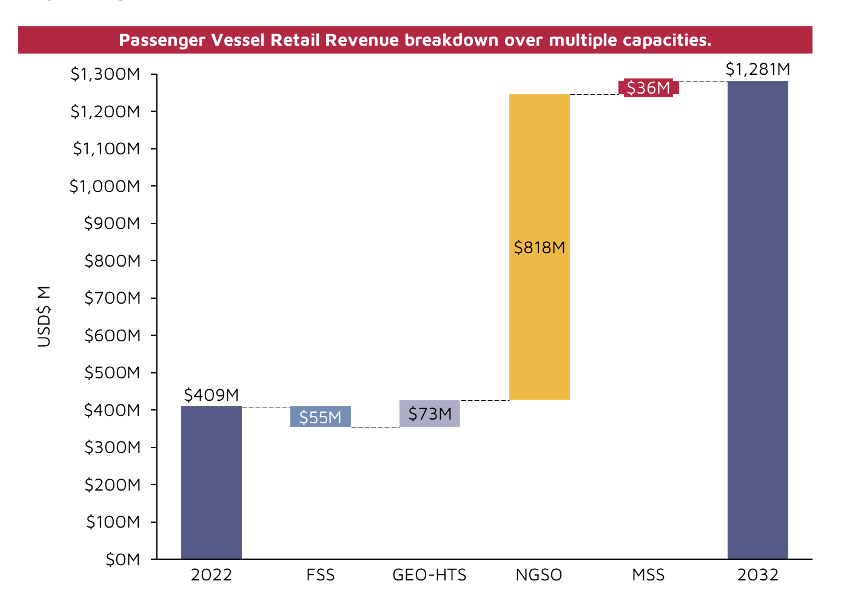Decarbonization Requirements Present an Opportunity for Enhanced Cruise Ship Connectivity
The adoption of smart network management onboard cruise ships will achieve smooth onboard operations for crew and offer the capability to optimize overall operations to meet carbon emission goals. The drive to lower carbon emission across the maritime market is intensifying as carbon intensity measures come into effect in 2023. Connectivity is a core component of understanding and reducing carbon emissions. Although Cruise end-users are heavy consumers of satellite connectivity across multiple orbits, operational demands will continue to drive more connectivity demand.
State of the passenger market:

The passenger market will account for 18% of retail revenues within the NSR Maritime Connectivity, 11th Edition, and will exceed USD$ 7.5 billion in cumulative retail revenues from 2022 to 2032. Cruise ships have been addressing connectivity issues onboard vessels using a combination of GEO, MEO and LEO solutions, e.g., SES O3b mPOWER and SpaceX Starlink in Non-GEO (NGSO) orbits. Nevertheless, cruise ships will need to meet carbon emission targets outlined by the International Maritime Organization (IMO) to meet 2050 goals. This presents an opportunity for Service Providers to expand their connectivity options beyond guest connectivity.
Key opportunities for SATCOM providers/vendors to help customers meet their 2050 target:
Managing onboard systems to decrease carbon emissions and remotely monitoring a fleet are increasingly popular through the use of SATCOM solutions. Vessel operators can remotely monitor fuel consumption and emission from shore while also providing remote assistance to troubleshoot. This enables onboard teams to identify and correct any issues, which can lead to efficient operations and reduced emissions. Such adoption has been seen recently with Campbell Shipping integrating Fleet care and Fleet Secure by Inmarsat to enable remote maintenance, support, and repair. Frequently, these services rely on high quality video calls and other latency-sensitive real time applications.
Use of advanced communications through multi-dimensional satellite architectures can provide vessels with high-speed, reliable connectivity between vessels and shore. SATCOM enables cruise vessels real-time collaboration between crew members and shore-based experts, which can result in better decision-making and more efficient operations. For cruise ships, customers are increasingly demanding high quality connectivity which matches the onboard amenities. As such, more cruise ships are turning towards NGSO connectivity infrastructure as a key component of their onboard architecture. Overall, not only does better connectivity help to enable efficiency but it also opens the doors to a different customer base that are looking for a more luxury approach to remote working.
Key recommendations to SATCOM provider/vendors:
The optimization of any vessel requires the incorporation of smart ship technology built with sophisticated network management. Driven by the IMO targets, this has led to an increased interest towards connecting more onboard devices. For the Cruise industry specifically, commitments by the Cruise Lines International Association (CLIA) to achieve a net-zero carbon goal by 2050 will drive another wave of connectivity requirements. For end-users, the connectivity drives down the cost of maintenance and reduces the frequency and severity of breakdowns while meeting carbon emission goals.
The utilization of cloud solutions to store data is essential for cruise ships that have implemented smart networks. Cloud solutions unlock scale and shore-side IT practices. Better connectivity to the edge allows these services to reach where they will provide the most impact. In addition, cloud solutions enable seamless collaboration and data sharing between various stakeholders, such as vessel operators, port authorities, and shipping companies. Many cruise ship companies use cloud services for business intelligence, but optimization of these networks can help in the management of fuel and waste.
The Bottom Line:
To address the IMO carbon emission target for 2050, cruise ships, need to invest in upgrading their onboard network. As to achieve smooth onboard operations, a blend of cloud-based solutions and smart networks must be implemented. The cruise liner market has already invested in advancing their connectivity, but their next investment will need to be directed towards “upgrading” network management.
